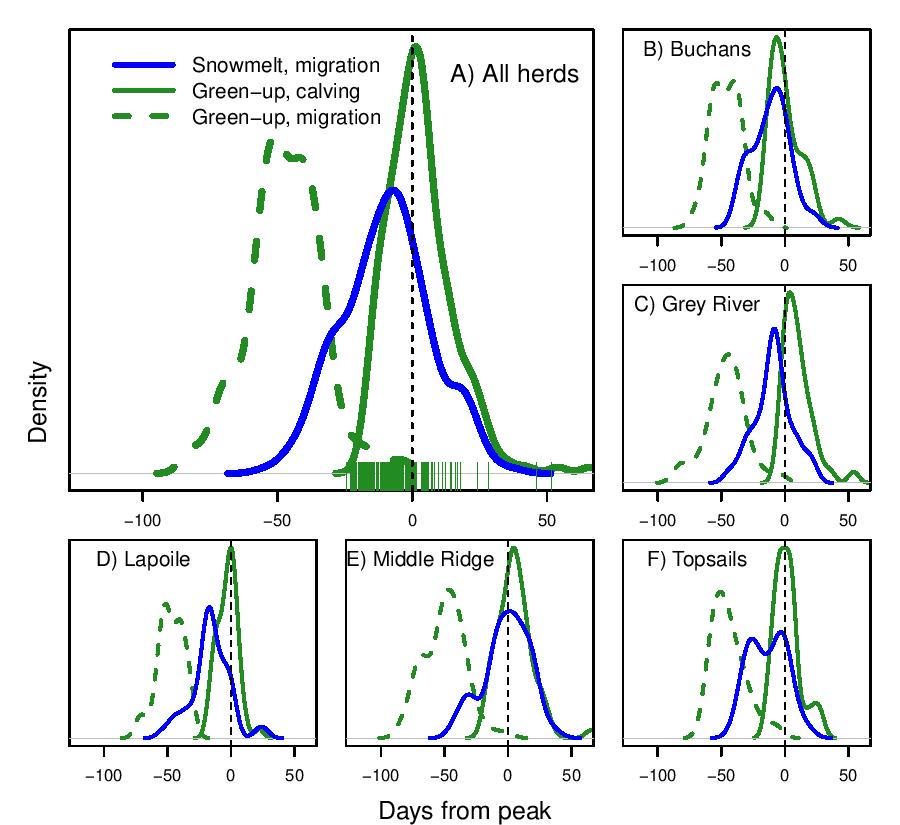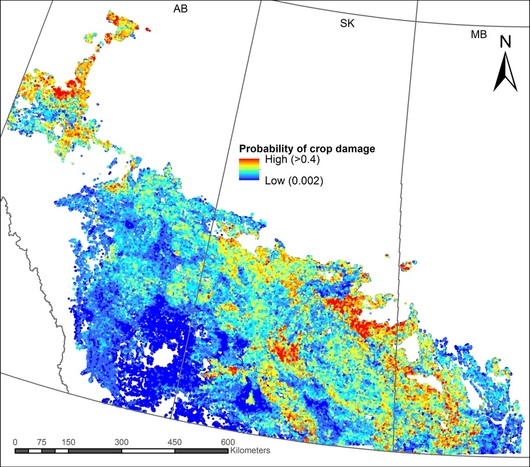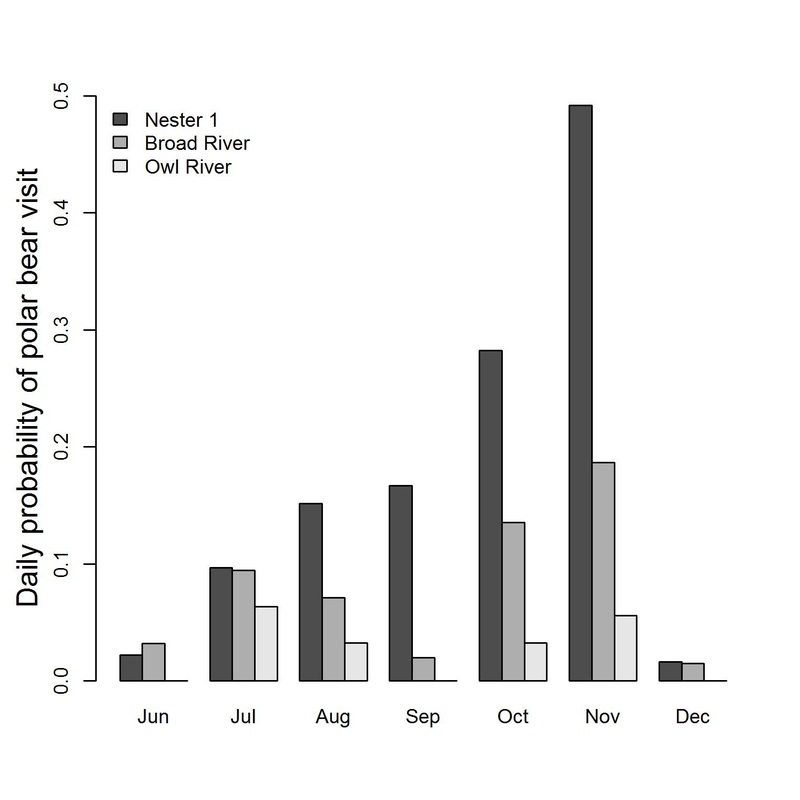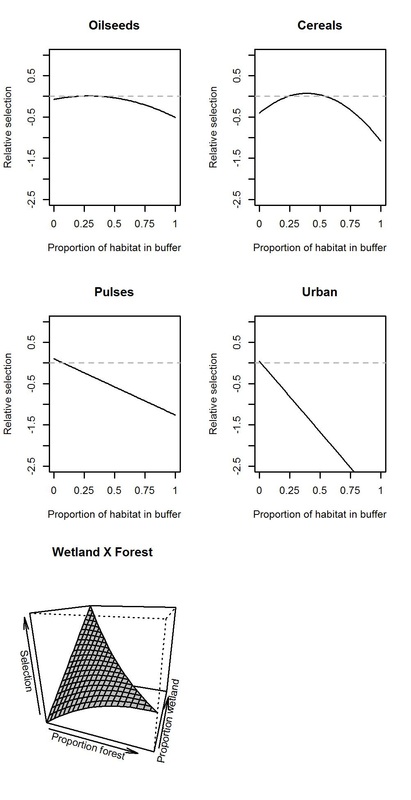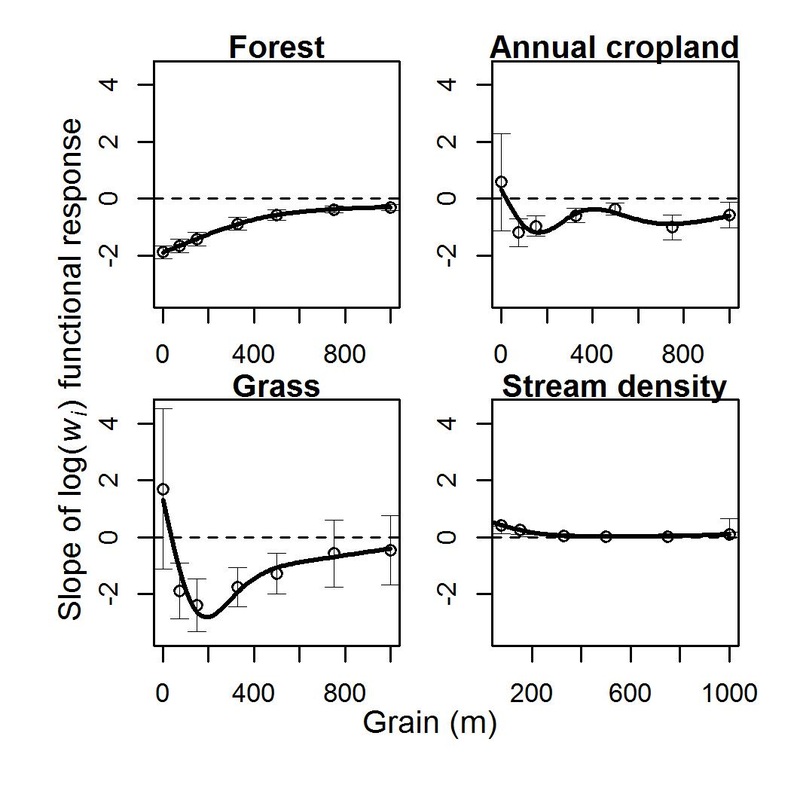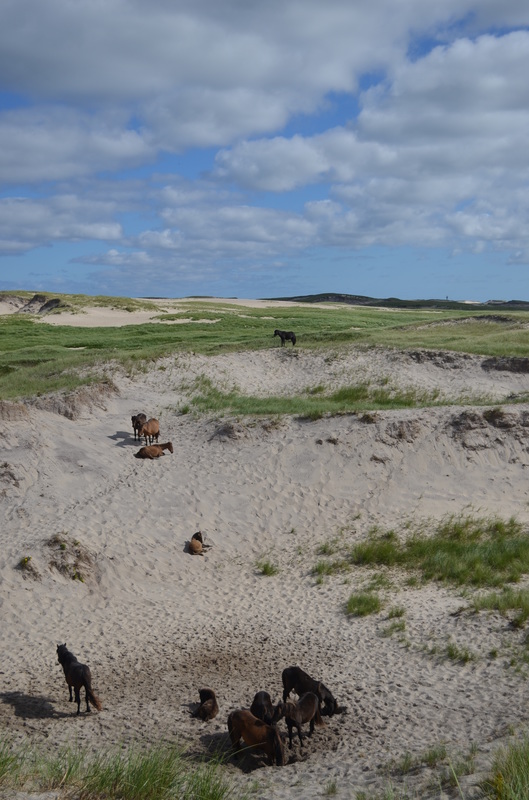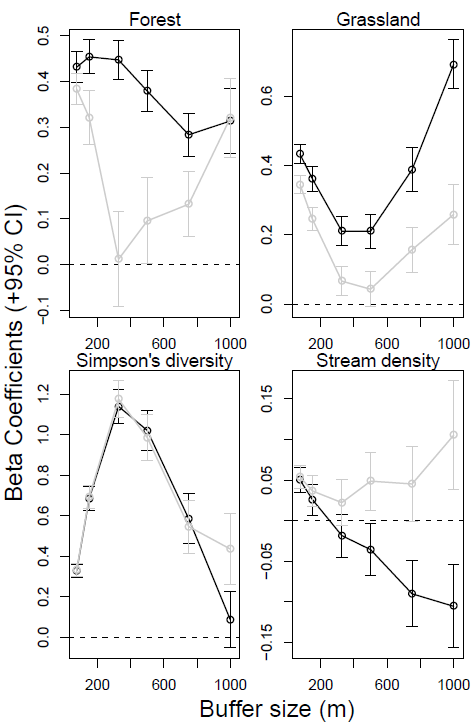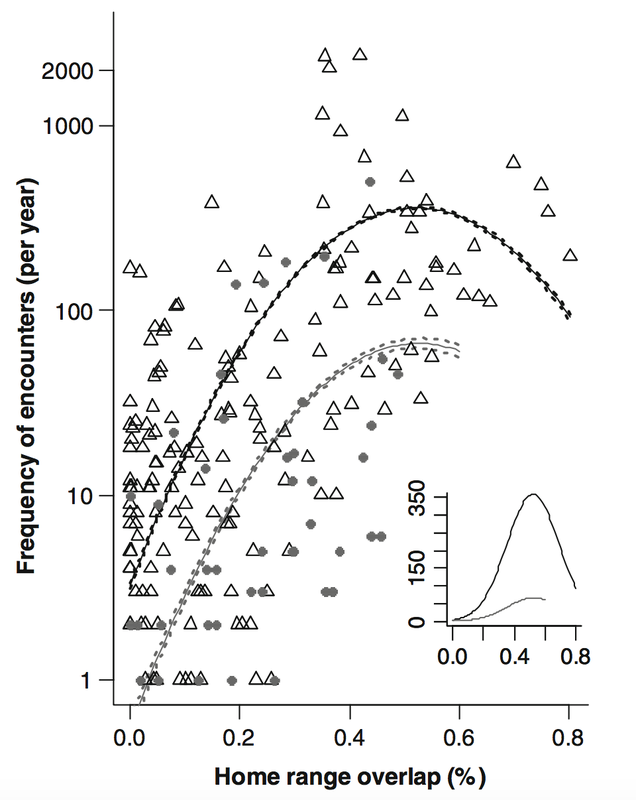Selected Publications
|
Density plots for caribou (Rangifer tarandus, n = 94) selecting for peak IRG (green lines) and snow-off (blue lines) during migration (dashed lines) and calving (solid lines). Density plots represent the densities of “surfing indices” (the mean number of days away from the peak of IRG/snow-off) for each individual. Values near zero (vertical dashed lines) indicate individuals with mean locations close to green-up/snow-off. Panel A) is data for individuals from all herds, B–F represent data from individual herds: B) Buchans; C) Grey River; D) Lapoile; E) Middle Ridge; and F) Topsails. Green hash marks on panel A represent parturition dates.
|
Phenological drivers of spring migration in Newfoundland caribou
Laforge, MP, M Bonar and E Vander Wal. 2021. Tracking snowmelt to jump the green wave: Phenological drivers of migration in a northern ungulate. Ecology, In Press (JIF: 4.70). Spring is energetically costly for female herbivores, as they face heightened energy demands from migration, gestation, and lactation. Spring in northern climates is a time of rapid environmental change: melting snow facilitates foraging and travel, and newly-emergent vegetation provides a valuable nutritional resource. These processes are spatio-temporally variable; thus, habitat selection for herbivores in spring is a process that requires individuals to be plastic in response to environmental change. Individuals must optimize the timing of important life-history events such as migration and parturition and adopt habitat selection strategies that maximise use of profitable resources. We used remotely-sensed data to examine the timing of female caribou migration and parturition as a function of two measures of environmental change—snow-melt and vegetation green-up. Our results show that caribou migration typically occurs shortly after snow melt, with parturition and the subsequent energetic costs associated with lactation occurring during the peak of green-up. Our results have implications for understanding how herbivores adjust their migratory behaviour in the face of climate change to ensure access to resources when energetic needs are highest. https://esajournals.onlinelibrary.wiley.com/doi/10.1002/ecy.3268 |
|
Climate-Induced Changes in Latitude of Farmland Moose Crop Damage Laforge, MP, NL Michel, and RK Brook. 2017. Spatio-temporal trends in crop damage inform broad-scale distribution of moose in a novel agro-ecosystem. Scientific Reports 7:15203. A changing climate is resulting in changes in animal distributions. Moose are a novel occurrence in agricultural systems, despite the fact that ungulates are well adapted to such areas. We investigated how climate affects the latitude at which moose damage crops throughout the Canadian Prairies. We also quantified crop damage risk as a function of landcover to assess how land use changes may be affecting moose distribution. https://www.nature.com/articles/s41598-017-15438-x Right: Probability map of crop damage across the Canadian prairies |
|
Polar Bear Field Camp Visitation Phenology
Laforge, MP, DA Clark, AL Schmidt, JL Lankshear, S Kowalchuk, and RK Brook. 2017. Non-invasive monitoring of temporal aspects of polar bear activity during seasonal ice-free periods. Polar Biology, 40:1661-1670. In the Canadian sub-Arctic, polar bears make seasonal use of terrestrial habitats as sea-ice declines and bears are forced to come ashore. Wapusk National Park near Churchill Manitoba is a hot spot for polar bear activity when Hudson Bay is ice-free. We used trail cameras to quantify the timing of visits by polar bears to remote field camps in Wapusk NP to assess the relationship between seasonal phenology and bear occurrence. Read the article here Left: Probability of polar bear visits to three field camps in Wapusk NP by month. |
|
Farmland Moose Habitat Selection
Laforge, MP, NL Michel, AL Wheeler, and RK Brook. 2016. Habitat Selection by Female Moose in the Canadian Prairie Ecozone. Journal of Wildlife Management 80:1059-1068 Moose are a relatively recent phenomenon in the Canadian Prairies, and as such little is known of their resource selection patterns in such agro-ecosystems. Using collared female moose, we generated resource selection functions for moose in south-central Saskatchewan for summer and winter. Moose showed a non-linear response to most crop types, avoided urban/developed areas and selected for wetlands and forests. Pothole wetlands, often surrounded by forest patches likely serve as important thermoregulatory habitat for moose in such systems. http://onlinelibrary.wiley.com/doi/10.1002/jwmg.21095/abstract Right: Relative selection of farmland moose to various landcover types in winter. 
|
|
Grain-Dependent Functional Response
Laforge, MP, RK Brook, FM van Beest, EM Bayne, and PD McLoughlin. 2016. Grain-dependent Functional Responses in Habitat Selection. Landscape Ecology 31:855-863 Animal's select habitat differently depending on the relative abundance of that habitat that is available to them, a functional response in habitat selection. Our understanding of animal habitat selection also varies depending on the scale at which habitat variables are quantified. Here, we examined the functional response of white-tailed deer to different habitats across a spectrum of spatial scales (grain sizes). We found that functional response to many habitat types varies as a function of grain size, with the magnitude of the response tending to diminish at larger grain sizes. This underscores the importance of scalar considerations when quantifying ecological phenomena. http://link.springer.com/article/10.1007/s10980-015-0298-x Left: The slope of the functional response of white-tailed to various habitat types. A slope of 0 indicates no functional response (use increases proportionally to availability). |
|
Scale-Dependence in Density-Dependent Juvenile Survival
Laforge, MP, A Uzal, SA Medill, and PD McLoughlin. 2016. Scale-Dependent Effects of Density on Foal Survival in Feral Horses. Journal of Wildlife Management 80:347-354 Density is well known to affect survival of juveniles through various mechanisms. Defining density, however, is contingent on the scale at which it is measured. In this paper, we examined conspecific density of horses on Sable Island, NS at three buffer sizes and at the island-wide scale. We found that island-wide conspecific density had a greater effect on juvenile survival than density at local scales. This suggests that Sable Island horses may disperse across the island to make maximal use of available resources. onlinelibrary.wiley.com/doi/10.1002/jwmg.1015/abstract Right: Horses exploiting limited freshwater resources on the Eastern side of Sable Island, NS. |
|
Multi-grain Resource Selection Functions
Laforge, MP, E Vander Wal, RK Brook, EM Bayne, and PD McLoughlin. 2015. Process-focussed, multi-grain resource selection functions. Ecological Modelling 305:10-21 The importance of scale in animal habitat suitability models is well established, as animals are known to select different resources over different spatial and temporal scales. Scale is typically studied by modifying the extent over which habitat is considered available to an individual. Here, we examined how changing grain (buffer size over which ecological data are quantified) affects resource selection functions (RSFs, a regression of used vs available habitat points on the landscape). We found that white-tailed deer selected habitat at different grains for different habitat types, and that multi-grain resource selection functions were more informative than models produced at only a single point or single grain size. Our results highlight the importance of examining both aspects of scale—extent and grain—when quantifying animal habitat selection. http://www.sciencedirect.com/science/article/pii/S0304380015000964 Left: Beta-coefficients and 95% confidence intervals for parameter estimates for white-tailed deer resource selection as a function of buffer size (grey = within-home-range, black = landscape-level). |
|
Gambit of the Group
Vander Wal, E, MP Laforge, and PD McLoughlin. 2014. Density dependence in social behaviour: home range overlap and density interacts to affect conspecific encounter rates in a gregarious ungulate. Behavioural Ecology and Sociobiology 68:383-390 Group composition and shared space use is often used as a proxy for interaction rate among individuals. Here, we examined the correlation between home-range overlap and interaction rate in female elk (Cervus canadensis) across two density treatments to test the "gambit of the group". We found that interaction rate was non-linearly related to home range overlap and was density dependent, with individuals interacting more at higher densities. http://link.springer.com/article/10.1007/s00265-013-1652-0 Right: Interaction rate as a function of home range overlap at low (grey circles) and high (triangles) densities. Lines represent generalized linear models and associated 95% CI. Inset: the relationship plotted in anti-log space. |
Contact:
Michel Laforge
Department of Zoology and Physiology
University of Wyoming
Biological Sciences 439
1000 E. University Ave.
Laramie, WY
82071
E: [email protected]
T: @MamlSpatialEcol
Michel Laforge
Department of Zoology and Physiology
University of Wyoming
Biological Sciences 439
1000 E. University Ave.
Laramie, WY
82071
E: [email protected]
T: @MamlSpatialEcol
